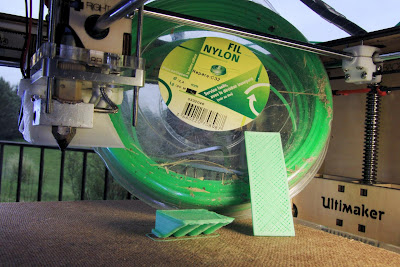Is filament quality so important after all?
I heard that Trimming line was one of the many materials that was experimented with a 3D printer (check my review), but this time I tried by myself. |
| Really, trimmer line may be a fully compatible filament ! |
First of all... How shall I call it really? This is the consumable that you buy for your, huh, weed eater, weed-wacker, edge trimmer, line trimmer, whipper snipper, string trimmer, weed whip, or strimmer... I headed to the wikipedia to know, and it listed all these synonyms! No standard then :)
A video showing it all - seeing it is believing :)
As you can see in the above video, I did not even clean the trimmer line before I sent it to my feeder (my head is doomed anyway imo, see below!). The diameter is 2.4mm, and seem pretty constant.
If you want to know more about the feeder, have a look at this post.
Filament diameters, bowden tube and feeder...
When you have a 1.75mm filament and an Ultimaker, you simply can slide a secondary thinner bowden tube in the primary one to guide it properly.
But I bet there are no such combination for a 2.4mm filament like mine. No biggie, I just want to know if it works. So I just fed it through my usual 4mm inner diameter bowden tube. The whole was quite springy obviously. I did not try prints with retraction enabled, but I expect values of 8mm at least.
| My feeder and bolt were made for a 3mm filament, but it worked fine with this one. The piece of red/pink filament prevents it from shifting inwards, and is better replaced with another piece of Nylon. |
I fully tightened the spring of my feeder because the central groove of the bolt lets this filament slip a bit otherwise. I could have made another bolt but I just bought new and fresh 3 mm trimmer line, as I was happy with this test..
Trimmer line as a filament: how good?
Filament moisture is often discussed, almost always fought, and it is sometimes considered a major issue. Well, my 10-year old trimming line here almost certainly absorbed all the water it could so far, and it was raining when I printed the samples!That was probably one of the worst setup I could set up, but the results were still very good in my opinion! So much for the moisture...
Best is to 3D print Nylon on hardwood or fiberwood
That is the first time I print nylon on something else than hard cardboard. Nylon does not warp and does not need a fan, which is very nice. But it fails to stick on most surfaces, and wood is a good candidate. I stopped using cardboard because it bent too easily and it usually got destroyed anyway when the print it detached. MDF (medium-density fiberboard) was a bit too sleek for me also.
So I used instead some hardboard (or fiberboard) that I came from the back panel of a piece of furniture. The rough side worked really well: no need to squeeze the first layer too much as it then sticks too much and damages the wood.
Nylon overhangs and bridges: excellent !
Nylon is a very interesting material: somehow flexible, it almost cannot be torn and gets its shape back after being tortured. As it elongates easily and a lot, bridges are very easy to achieve. Also, since the layers weld to each other very well, it is also quite easy to print large overhangs as shown below.| Large overhangs are surprisingly easy (0.15mm layer height) : no support neither raft are needed, contrary to MakerBeck recommendations (source: Black & Decker workmate part gripper). |
| Same excellent behavior for bridges; even this dirty trimmer line makes it easy, as the threads extend a lot. |
| Here is a small gear for the feeder stepper motor. I expect its strength to exceed that of my PLA version. |
Specially made Taulman nylon vs nylon trimmer line ?
Let me compare with the fresh 3mm Taulman 618 Nylon I bought for 35€ plus 18€ for shipping and handling (it is about 54m). It certainly gives nice and smooth results, but my experiment with trimmer line showed me that I could get surprisingly good results also with an old and dirty one.
And... I was able to buy a slightly longer roll of 3mm trimmer line for only 22 €, including shipping. I still have to test this brand though, because the chemical components may not be well suited to 3D printing compared to that of the Taulman Nylon.
I did not buy the cheaper even 120m roll (only 30€ with S&H) because if it fails to print it will not be usable with my trimmer tool! ;) Obviously, I carefully avoided square- or diamond-shaped filaments.
Conclusion
I will probably keep the Taulman brand for safe & quality prints or client work, but trimmer line will probably be my cheap substitute to ABS. It produces indestructible and somehow flexible parts just like any other Nylon. I should better print something dryer though and trimming line resellers will certainly not car about it, so active and preliminary drying is probably useful for better prints.
Trimming line comes is a few colors, so you get more choices as with specifically made nylon filaments, else you may head again to richrap and his tie-dye experiments.
One last hint: please if you try, buy only round filament: diamond-shaped ones are no good ;)
| For reference, I printed teh white fan duct (not so neatly) with the specially engineered Taulman 618 Nylon, My very old and dirty greenish trimming was however surprisingly good, so I bought some fresh one (in 3mm), and I expect to have significantly better results. I will post some pictures when I am done. |